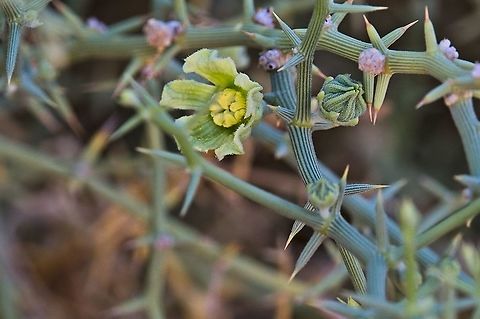
Appearance
It is a dioecious, leafless, phreatophyte that is found in sandy deserts but not stony plains, in areas with access to ground water such as ephemeral rivers and paleochannels, where sand accumulating in the shelter of its stems can form hummocks up to 1000–1500 m2 in area and 4 meters in height. Its stems may rise more than a meter above the hummocks, while its system of thick taproots can extend up to 50 m downward. The plant is leafless, so modified stems and spines 2–3 centimetres long serve as the photosynthetic "organs" of the plant. The plant can survive many years without water.Habitat
Its sand-binding characteristics also help nara form microclimate within the desert dunes. These microclimates provide food and shelter for a variety of vertebrates. Presence of the nara plant is associated with significantly increased soil microdiversity likely due to the shade it provides and the attraction of foraging mammals which contribute to organic matter.''Acanthosicyos horridus'' typically occurs in the absence of other vegetation due to the harshness of the climate, though ''Eragrostis spinosa'' and ''Stipagrostis sabulicola'' grasses may grow between its hummocks. It is regarded as a keystone species because its melons, seeds, shoots, and flowers are food sources for beetles, gemsbok, and ostrich, while small rodents such as ''Rhabdomys pumilio'', ''Desmodillus auricularis'', and ''Thallomys nigricauda'' take shelter amid the spiny tangle of its stems. The katydid ''Acanthoproctus diadematus'' feeds on the plant, moving between different bushes at night.
Uses
The melon fruits average 1 kg and are pale green and spiny. Within it has a sweet, aromatic, watery, yellow-orange pulp. The large edible seeds, white to cream in color, are known as butter-nuts or butterpips. These have been exported for use in baked goods.The fruit serves as a food source for Nama people from February to April and August to September.
References:
Some text fragments are auto parsed from Wikipedia.